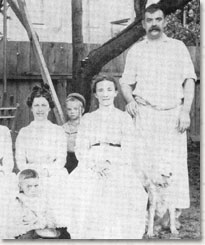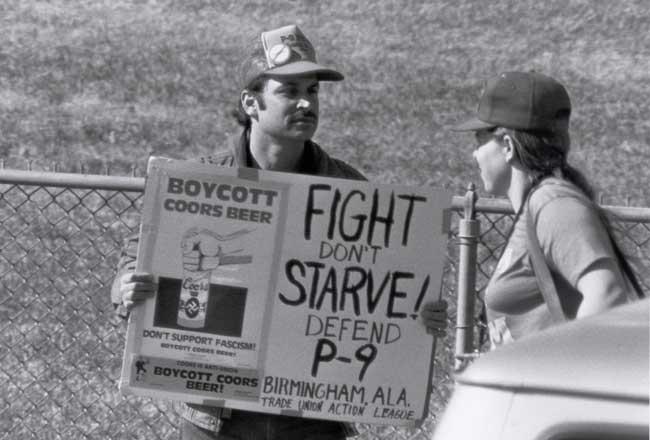
This Day in Labor History: April 20, 1946. The International Fishermen and Allied Workers of America (IFAWA) Local 46, a communist led union of largely Native Alaskans, walked off the job to demand wage increases, shorter workdays, and the closed shop. Let's talk about this win! 

First off, I am very pro IFAWA salmon union logo. I need a t-shirt of this.
Working in solidarity with Food, Tobacco, Agricultural, and Allied Workers (FTA) Local 7, which largely represented Filipino salmon cannery workers, this successful strike demonstrated the potential of cross-racial organizing among workers.
The IFAWA came into existence in 1939, the latest of a number of attempts to organize the fishing industry of the Northwest, Canada, and Alaska. This was an industrial union that fought against the craft unionism that had dominated the industry’s organizing for decades.
The new union affiliated with the CIO, who saw great potential in organizing the fishing industry, and it merged a number of preexisting smaller locally-based unions into one.
It was entirely American, but it had close allies with a British Columbia-based union, the United Fishermen and Allied Workers Union. The formation of a large fishery workers unions was fraught with racial tensions.
The Italians and Slavs who worked in California wanted nothing to do with Filipinos and Japanese. Even Italians themselves were not welcome in some locals.
The union also struggled with attempts at forming cooperatives that would undermine unionization by dreams of being a capitalist. It was a hard industry to organize.
Seasonality meant workers only labored at it part of the year and moved elsewhere to work. Some boats were at sea for long periods and others went back and forth each day.
The fishpacking owners were outraged at the idea of a militant industrial union led by socialists. Relying heavily on injunctions to stop collective bargaining by claiming the workers were independent contractors, they were able to slow the effectiveness of the union to win.
In Alaska, the Alaska Fishermen’s Union and United Fishermen’s Union built up the IFAWA. The former organized heavily in the Native population, though the union itself was dominated by officials out of Seattle.
World War II opened up more opportunities for Native Alaskans and women of all races in the industry, as it did for minorities throughout the nation. That the union had a long history of anti-Japanese rhetoric certainly did not hurt it during World War II.
This wasn’t so much targeted at Japanese-Americans so much as it was against the actual Japanese fishing industry, which had long been major competition for the Americans, both in terms of fishing groups and the potential of cheap fish imports from that nation.
But the union did say nothing against Japanese internment, to its moral detriment. Being a communist-led union, the IFAWA strongly supported the U.S. effort in World War II, even as it caused some hardships for workers, such as port closures for security reasons.
That meant supporting the CIO’s anti-strike clause, even as the rank-and-file balked and the salmon industry remained as anti-union as ever.
The inclusion of so many women into the workforce by 1943 really transformed the IFAWA. That year, the union pushed for new demands such as better childcare and equal pay for equal work.
Traditionally a male dominated and patriarchal union, the arrival of women in the workforce in large numbers forced a change in priorities and organizing strategies. But World War II was tough for the union.
The National War Labor Board ordered the salmon canneries to pay more money. And they simply refused to do so. We don’t actually know the final outcome of this, but it seems like the canneries never did pay it. The NWLB always did have limited and unclear power.
One major move for the IFAWA during the war was the creation of Local 46, representing Native workers in Bristol Bay. Traditionally discriminated against and denied most jobs, the war changed their position in the economy as it did for women.
Now the canneries hired Native peoples in large numbers. For Asian cannery workers, mostly Filipino and Japanese, conditions were bad–terrible living conditions in bunkhouses and discrimination from the companies. But Native workers had it worse.
They were paid less for the same work and not provided housing at all for their seasonal labor, forcing them to live in homeless encampments, made often of cardboard.
Company stores and high prices ensured they stayed in debt, which also helped keep them around as a reserve pool of labor.
The fact of the matter was that the non-Native workers were pretty much fine with all of that and did not want indigenous people to be equal within the union. So forming an all-Native local was an important step.
After the war ended, the IFAWA ended its no-strike pledge. By 1946, its workers were ready to strike, part of the larger strike wave across the nation that year. That included Local 46.
To pull off a strike though, it had to work with FTA Local 7, which represented the largely Filipino cannery workers who mostly lived in Seattle, Portland, and San Francisco but who would ship out to Alaska for the salmon season.
Local 7 had often resented the Native workers because they were cheap labor undermining their bargaining position. But with Local 46 organizing, they saw a chance to improve everyone’s situation.
On April 20, Local 46 went on strike, just before the Filipino workers started to Alaska. This was also good timing because coincidentally, there was already a longshoremen’s strike happening.
That ended April 22, but there was a lot of pressure on the salmon industry at this time. With the longshoremen not letting goods off boats, the area, significantly reliant upon imports of food, was quite worried.
So after the longshoremen’s strike ended, both Local 46 and Local 7 were sure to get food into Alaska to stave off any shortages, earning them good will from the population.
The demands of Local 46 were pretty straightforward, mostly around wage increases. And with the pressure from both within and without, the canneries caved in a week.
On April 27, they settled, giving the workers a 10 cent wage increase and stand-by pay for periods of inactivity for Local 7 members. Local 46 won a 10 cent an hour raise to $1.06 (about $15 today) and an increased earnings guarantee for the season.
Local 46 had so much momentum that even after ending the strike, it kept keeping the pressure on.
By July, the canneries increased wages to between $1.10 and $1.35 an hour, depending on the job classification, as well as the 8-hour day, closed shop, and recognition of shop stewards. Moreover, they achieved equal pay for women, nearly unheard of in union contracts at this time
After this major victory, there was talk about the FWA and IFAWA merging, but jealousies and personal histories got in the way of that.
The IFAWA continued pushing hard in Alaska, even as it was struggling in California and with the new anti-communist requirements of the Taft-Hartley Act of 1947.
Despite a big west coast-wide salmon strike victory in 1949, the CIO kicked the union out of the federation for its communism that year.
Local 46 was one of the locals that soon joined the International Longshore and Warehouse Union and continued to see successes under that radical but not actually communist organization.
But infighting and the CIO trying to raid the local to create a non-communist rival simply destroyed the local entirely, with most workers just dropping away.
I borrowed from this very long Leo Baunach essay at the University of Washington’s Civil Rights and Labor History Consortium to write this thread. Lots more information here!
depts.washington.edu/dock/IFAWA_pt1…
depts.washington.edu/dock/IFAWA_pt1…
Back tomorrow to discuss Spanish colonialism and the infamous mine at Potosi, Bolivia.
• • •
Missing some Tweet in this thread? You can try to
force a refresh








